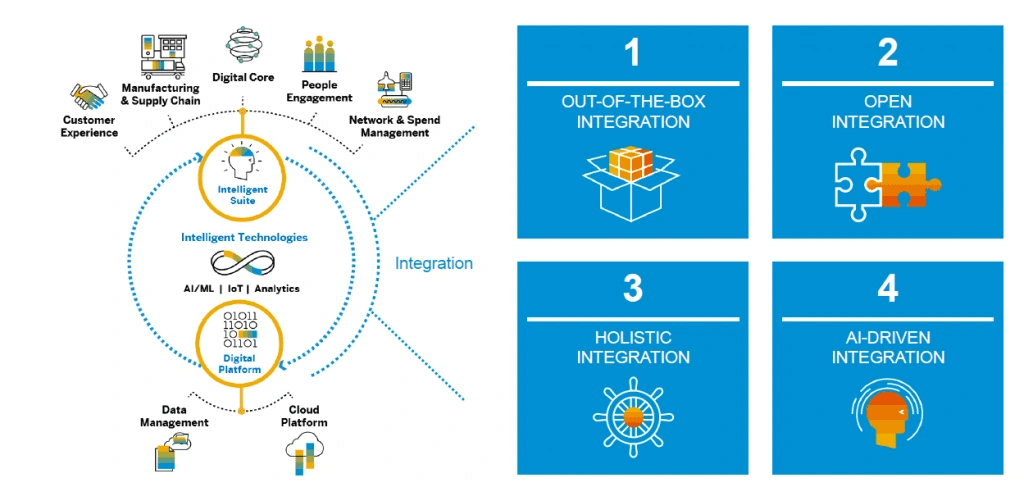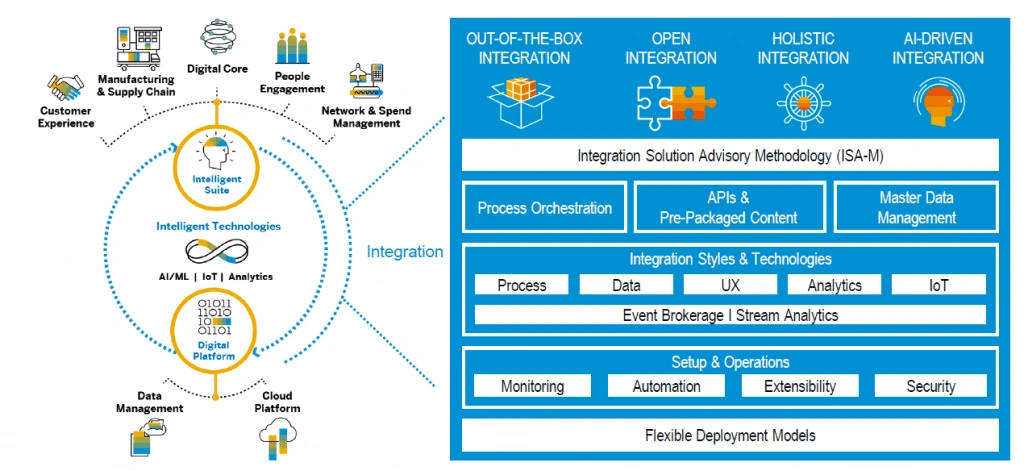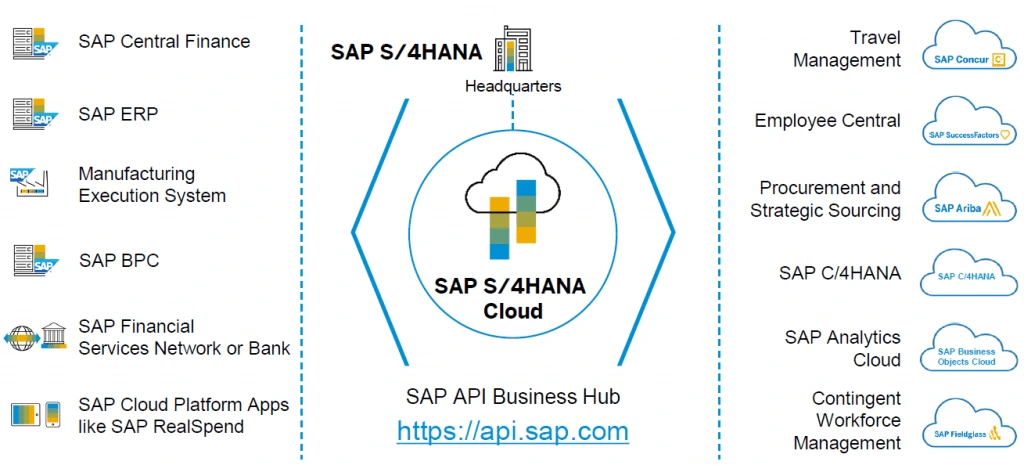SAP Integration is Key to SAP Intelligent Enterprise
SAP Integration is Key to SAP Intelligent Enterprise.
Introduction
The early 90’s saw a great increase of IT products and tools, which helped every industry to develop IT solutions for transforming the operations from manual to “computerised” systems. The result of which was the creation of many “island solutions”, such as purchase, sales, inventory systems etc… which helped to achieve automation/optimisation within a function or department in every organization. However, this led to duplicate/inconsistent data across these island solutions which left Management with confusing inputs and lack of reliability for their decision making. ERP solved many problems for customers, especially larger ones, which was “integrating” multiple solutions. SAP ERP has been a very successful, tightly integrated, solution for more than 20 years. With new innovations and developments in technology & architecture, S/4 HANA, SAP Leonardo, and other solutions are more modular and hence Integration is of paramount importance. This blog explains the theme of “integration” to build an Intelligent Enterprise.
SAP has articulated the key pillars of its Integration strategy. The value of SAP Integration is built on the following 4 pillars as shown in Exhibit - 1.

Out of the box Integration represents the set of readily usable integration components such as SAP Data Hub, Master Data services and SAP Cloud Platform integration to connect a suite of applications.
Open Integration represents the set of public APIs and pre-packaged integration scenarios to integrate enterprise apps as well as Non-SAP data/processes including the ability to integrate with Business Partners.
Holistic Integration represents the SAP hybrid integration Platform for end-to-end digitisation, flexible deployment options and “Integration Solution Advisory Methodology” (ISA-M).
AI-Driven Integration represents the AI and machine learning capabilities embedded in SAP Processes to provide Context Based Assistance and automate processes using Intelligent Robotic Process Automation (RPA) Services.
Integration - Overview:
SAP’s vision for integration is portrayed in the diagram shown in Exhibit-2. On the left side, you will observe the Intelligent suite & Intelligent technologies. On the right side, the integration components and themes are shown. They are supported by the four integration pillars we saw earlier.

Let us understand the key blocks represented in the above diagram, in a little more detail.
Process Orchestration:
This is the implementation of business processes from the process documentation into a model-driven implementation. Using SAP Cloud Platform Workflow, you can build or modify rapidly workflow applications. Tailoring or extending pre-delivered cloud-based applications and workflows can be accomplished easily. SAP Cloud Platform Business Rules component helps to externalize the business logic from the applications. It makes it easy to manage the business logic independently and developers can use them with RESTful APIs in their applications. SAP is working on Process Visibility Dashboards and Scenario Models. These can provide a comprehensive view of processes in real time which can lead to identifying bottle necks easily. The goal is to provide end-to-end visibility across Cloud, Hybrid and On-Premise Landscapes as depicted in Exhibit - 3 below.

Event Brokerage and Stream Analytics:
SAP is building an Event Driven Architecture to consume system events in the cloud. The principles of an event driven architecture are that as and when events happen in real-time, they are pushed to an Event Broker on a “fire and forget” mode. The Event Broker manages all such notifications and shares them appropriately to applications, dashboards or monitoring terminals. SAP Cloud Platform Enterprise Messaging frame work supports high volume and high-speed communications across SAP applications. This allows for seamless communication and integration across different platforms. Exhibit - 4 below shows this in a simple diagram for easy understanding. SAP HANA has an inbuilt streaming analytics capability. Using this, it can combine raw events, apply complex business logic and machine learning functions and convert them into an actionable information such as alerts/notifications in dashboards.

Master Data Management:
SAP Cloud Platform provides for Master Data Services for master data integration/consumption by different Cloud applications. This also provides for Master Data Governance for enterprise wide Master Data Management. It has CRUD Services, federation and replication for reuse by all cloud applications. This helps to avoid the overhead of own persistence in individual applications. SAP is having a broader vision of going beyond master data services and delivering other business services. For example, providing shopping cart services which will aggregate the items picked by a customer on an e-com website. SAP is also planning to provide some generic services such as currency conversion services, unit of measurement conversion services, user login services, data search services and the like. It is depicted pictorially in the exhibit - 5 below, which are just illustrative in nature. This Blog post by a technical expert provides more information with regard to this topic.

Process Integration:
This deals with application-to-application integration, B2B integration and Business to Government integrations. SAP Cloud Platform provides for all Process Integration requirements with different services. It has out of the box connectors and application specific adapters to connect SAP Applications. It also has pre-built Mediation capabilities to aggregate, route, sign and encrypt the data. The relevant APIs are provided via SAP API Business Hub. Exhibit - 6 below shows the SAP Cloud Platform integration for cloud and hybrid Process Integration.

SAP has also pre-delivered, SAP-to-SAP integration for SAP S/4 Hana Cloud. A sample of this is provided in the exhibit - 7 below.

Analytics Integration:
This deals with integrating data from different sources to provide real time intelligence to business decision makers. SAP Analytics cloud is a solution, which is built to deliver “Smart Insights, Smart Discovery and Smart Predict”:
- Smart Insights feature provides contributing factors behind historical performance.
- Smart Discovery uncovers hidden pattern in data.
- Smart Predict uses Machine Learning algorithms to provide predictive capabilities.
SAP is working to provide pre-configured scenarios, embedded directly in SAP applications. More details can be obtained from SAP Analytics Cloud.
IoT Integration:
SAP Leonardo provides quite a few services in the context of IoT integration. There was an earlier Blog on SAP Machine Learning Foundation, where this is explained in more detail.
Summary:
In the current technologically advanced environment, there are more solutions to be integrated effectively to build an Intelligent enterprise. SAP Cloud Platform, along with other solutions such as SAP Data Hub and SAP Analytics Cloud, helps to integrate and automate many of the day to day activities and serve meaningful, context sensitive information in an embedded form, directly in applications. SAP is building solutions to automate the integration process itself, however, this may be a topic for another Blog. SAP Consultants and Architects, can certainly bring out much more value, just by ensuring appropriate integration solutions. This is an exciting area to jump into to differentiate oneself from the crowd!
Wishing you all good luck with your integration!
References:
Intelligent Enterprise and SAP Leonardo
SAP Data Hub
Virtual Event: Transition to intelligent enterprise
Event: Intelligent enterprise for Oil & Gas sector
Author : Ravi Srinivasan, SAP Alumni